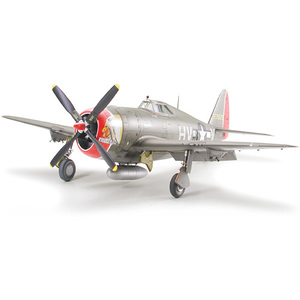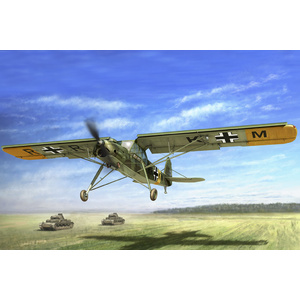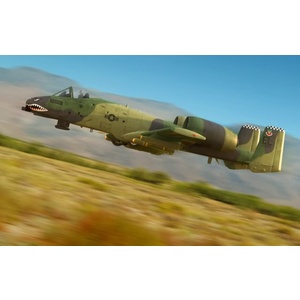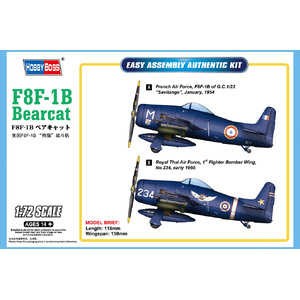
Tamiya 61086 Republic P-47D Thunderbolt? "Razorback" 1/48 Scale Aircraft Series no.86
$48.99
PART FINDER (Under Construction)
SKU code: HKM01E010
Make 4 interest-free payments of $112.25 fortnightly and receive your order now.
Calculate Shipping:
Share This Item:
Avro Lancaster B Mk. 1
From failure to success. The four engines Avro type 683 Lancaster was developed from the disappointing twin-engine Manchester, which suffered from engine fires caused by its unreliable Rolls-Royce Vulture engine-installation.
However, the basic Manchester airframe was of sound design. A logical solution was to increase the wingspan and replace the two Vultures with four Merlin engines. The engine-installation originally developed by Rolls-Royce for the Beaufighter II, was quickly adapted and fitted in graceful underslung nacelles. The prototype BT308 made its first flight on January 9th, 1941 and it soon proved to be an excellent aircraft with good handling and high load capability. Initially designated Manchester III, it was soon renamed Lancaster. The general outline of the Lancaster remained the same throughout production, apart from the MK II which was used in Bristol Hercules radial engines, in case a shortage of the Merlin should arise. The Mk 1 and III were similar, differing only in the type of Merlin engine fitted. In the case of the Mk III, the Packard built Merlin 28 was utilised. The Lancaster began to equip bomber squadrons in early 1942, where it quickly became the backbone of RAF Bomber Command.
The type was used in many famous raids, such as on the M.A.N. factory in Augsburg, the spectacular Dambusters Raid on the Ruhr Valley dams, and sinking the "Tirpitz" to name but a few. It became famous for its high accuracy bombing operations by 617 squadron. Its 33-foot-long bomb bay enabled it to carry high loads, as well as the spinning "Upkeep" mine used to break the Ruhr dams. Specially adapted aircraft could carry the massive 12,000 lb "Tallboy" and 22,000 lb "Grand Slam" earthquake bombs.
At the end of the war, it was also used for food dropping sorties for the starving Dutch population and transporting the many prisoners of war back home from Germany. Postwar Lancaster's were used for testing jet engines and in-flight refuelling system. As a bomber it was gradually replaced, but it found a useful role in Coastal Command until the last one was withdrawn in October 1956. The RAF and French L'Aéronavale, however, continued to use the Lancaster until the mid-sixties. A total of 7,377 Lancasters were built in the UK and Canada.
Instruciton (Full.pdf, 97,634 Kb) [Download]
Caution
| SKU | HKM01E010 |
| Barcode # | 4897041570113 |
| Brand | Hong Kong Models |
| Shipping Weight | 3.3000kg |
| Shipping Width | 0.370m |
| Shipping Height | 0.170m |
| Shipping Length | 0.670m |
| Shipping Cubic | 0.042143000m3 |
Help other RCMA Model & Hobby Shop users shop smarter by writing reviews for products you have purchased.

Tamiya 61086 Republic P-47D Thunderbolt? "Razorback" 1/48 Scale Aircraft Series no.86
$48.99
Make 4 interest-free payments of $12.25 fortnightly and receive your order now.

ICM 48100 Mistel 1 1/48 Scale Plastic Model Kit
Now $105.00
Make 4 interest-free payments of $26.25 fortnightly and receive your order now.

Tamiya 60749 North American P-51D Mustang? 1/72 Scale Model War Bird Collection no.49
$19.99
Make 4 interest-free payments of $5.00 fortnightly and receive your order now.

HobbyBoss 87275 TBF-1C Avenger Torpedo Attack Aircraft 1/72 Scale Plastic Model Kit
$48.99
Make 4 interest-free payments of $12.25 fortnightly and receive your order now.

HobbyBoss 80180 Fieseler Fi-156 A-0/C-1 Storch 1/35 Model Kit
$44.00
Make 4 interest-free payments of $11.00 fortnightly and receive your order now.

Academy 12295 USAF F-15E "Seymour Johnson" 1/48 Scale Plastic Model Kit
$74.99
Make 4 interest-free payments of $18.75 fortnightly and receive your order now.

HobbyBoss A-10A THUNDERBOLT II 1/48 80323
$44.99
Make 4 interest-free payments of $11.25 fortnightly and receive your order now.

HobbyBoss F8F-1B Bearcat 87268 1/72 Scale Model Kit
$16.98
Make 4 interest-free payments of $4.25 fortnightly and receive your order now.
Welcome to our website. If you continue to browse and use this website, you are agreeing to comply with and be bound by the following terms and conditions of use, which together with our privacy policy govern RCMA Model & Hobby Shop’s relationship with you in relation to this website. If you disagree with any part of these terms and conditions, please do not use our website.
The term ‘RCMA Model & Hobby Shop’ or ‘us’ or ‘we’ refers to the owner of the website whose registered office is . Our ABN is 88 645 881 223. The term ‘you’ refers to the user or viewer of our website.
The use of this website is subject to the following terms of use:
Privacy Policy
RC Model Aircraft is dedicated to keeping your details private. Any information, we collect in relation to you, is kept strictly secured. We do not pass on/sell/swap any of your personal details with anyone. We use this information to identify your orders, provide you with our monthly newsletter (if requested) and to personalise your shopping experience with us; that's all. RC Model Aircraft uses cookies to allow you to login to your account, maintain a shopping cart and to purchase items in your shopping cart. Cookies sent to your computer from RC Model Aircraft only last while you’re browsing our website. We do not store persistent cookies on your computer. Cookies also allow us to give you a more personalised shopping experience by displaying products that interest you throughout our product pages, thus providing you with a more friendly, interesting and enjoyable shopping experience.
Whenever you use our web site, or any other web site, the computer on which the web pages are stored (the Web server) needs to know the network address of your computer so that it can send the requested web pages to your Internet browser. The unique network address of your computer is called its "IP address," and is sent automatically each time you access any Internet site. From a computer's IP address, it is possible to determine the general geographic location of that computer, but otherwise it is anonymous.
We do not keep a record of the IP addresses from which users access our site except where you have specifically provided us with information about yourself, in which case we also record your IP address for security purposes. An example of this would be when proceeding to a checkout to finalise an order you may wish to make. After completing the form provided, your IP address will be stored along with a transaction number that allows us to track your order.
Security Policy
When purchasing from RC Model Aircraft your financial details are passed through a secure server using the latest 128-bit SSL (secure sockets layer) encryption technology.128-bit SSL encryption is approximated to take at least one trillion years to break, and is the industry standard. If you have any questions regarding our security policy, please contact our customer support centre webmaster@rcmodelaircraft.com.au

Simple instalment plans available instantly at checkout


Use your existing debit or credit card

No long forms, instant approval online

Pay fortnightly, enjoy your purchase straight away!
All your need is:
1) An Australian Visa or Mastercard debit/credit card; 2) To be over 18 years of age; 3) To live in Australia
To see Afterpay's complete terms, visit https://www.afterpay.com.au/terms
© 2025 Afterpay
